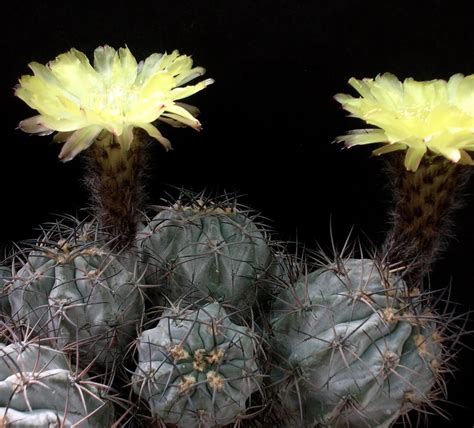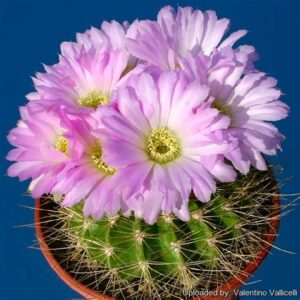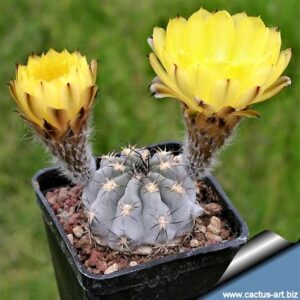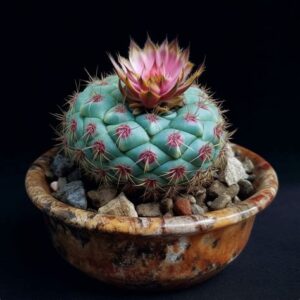In the vast realm of cacti, where adaptations and survival strategies intermingle, few specimens evoke as much fascination as Acanthocalycium glaucum, particularly the WR 872 variant. This exceptional cactus, native to the semi-arid regions of South America, is not only a treasure for collectors but also a beacon of the extraordinary diversity present in the cactus family.
Boasting a unique combination of aesthetic appeal and cultivation intrigue, the Acanthocalycium glaucum WR 872 holds a distinct place in the hearts of enthusiasts. At first glance, its striking appearance leaves an indelible impression, evoking curiosity and admiration. The waxy, glaucous coating that adorns its body gleams in sunlight, making it a visually arresting specimen. This distinctive feature, coupled with its intricate spine patterns, sets it apart in any collection.
Let us delve deeper into the captivating characteristics, cultivation practices, and ecological significance of this rare cactus variety, shedding light on why Acanthocalycium glaucum WR 872 deserves a spot in any serious enthusiast’s lineup.
The Enigmatic Appearance of Acanthocalycium Glaucum WR 872
One cannot discuss Acanthocalycium glaucum WR 872 without mentioning its remarkable visual appeal. This cactus’s body tends to be relatively short and barrel-shaped, reaching heights of up to 15 centimeters. Its strikingly glaucous coloration—ranging from muted blue-green to a steely gray—instantly attracts the eye. When touched, the surface feels waxy, a trait that minimizes moisture loss and enhances its drought resilience.
Perhaps the most intriguing aspect of Acanthocalycium glaucum WR 872 is its spiny armor. Long, slender spines emerge radially from the areoles, often displaying an unusual twist. These spines serve a dual purpose: they provide protection against herbivores while also reflecting light, creating an enchanting visual spectacle. The variation in spine coloration—ranging from pale yellow to deep brown—adds another layer of complexity to its aesthetic allure.
During the blooming season, Acanthocalycium glaucum WR 872 showcases one of nature’s most delightful phenomena: its flowers. Nestled atop the cactus, the blooms emerge in vibrant shades, often reminiscent of delicate watercolor paintings. The blossoms typically show a gradient of hues, transitioning from soft pastels to vivid reds and oranges. This seasonal transformation not only enhances its beauty but also underscores the cactus’s reproductive strategy—attracting pollinators with the promise of nectar.
Understanding Cultivation: Nurturing a Rare Gem
For those fortunate enough to acquire Acanthocalycium glaucum WR 872, understanding the nuances of its cultivation is paramount. This cactus exemplifies the delicate balance between nature’s demands and the grower’s attention to detail. It thrives in well-draining soils, ideally a mix of coarse sand and organic matter that mimics its native environment, promoting optimum aeration while preventing rot.
Temperature and watering practices are critical to its health and longevity. Native to regions where temperatures fluctuate dramatically between day and night, Acanthocalycium glaucum WR 872 appreciates a warm day but enjoys cooler nights. Such conditions can be replicated in cultivation by placing the cactus in a location that receives ample sunlight during the day while ensuring nighttime temperatures dip appropriately.
When it comes to watering, the general rule of thumb is to emulate its drought-resistant nature. The key is to allow the soil to dry out thoroughly between waterings, fostering a robust root system that can sustain the plant during dry spells. Overwatering is a common pitfall for novice growers, and Acanthocalycium glaucum WR 872 is no exception; signs of over-saturation manifest quickly, leading to potential root rot.
Another intriguing aspect of cultivating Acanthocalycium glaucum WR 872 is its susceptibility to certain environmental factors. The introduction of pests, including mealybugs and scale, can pose a significant challenge. Vigilance in regular inspections and implementing integrated pest management strategies go a long way in preserving the cactus’s health. Moreover, providing adequate airflow around the plant can mitigate issues related to mold and mildew, making it essential for a thriving environment.
The Relationship with Local Ecosystems
Beyond the appeal it holds for collectors and horticulturists alike, Acanthocalycium glaucum WR 872 plays a critical role in its native ecosystem. These cacti serve as essential shelter and sustenance for a variety of pollinators, including bees and butterflies. The vibrant blooms not only offer food but also create a vibrant landscape that supports biodiversity.
Furthermore, Acanthocalycium glaucum WR 872 embodies a crucial survival strategy for the arid terrains it inhabits. The ability to store water in its fleshy tissues enables this cactus to withstand prolonged dry periods, a characteristic paramount to its survival and an evolutionary marvel worth studying. Research into its adaptations offers insights into broader ecological patterns, particularly in understanding how flora contributes to ecosystem resilience in the face of climate change.
Moreover, the cultivation of Acanthocalycium glaucum WR 872 raises awareness about conservation efforts necessary to protect its natural habitat. As urbanization expands and climate shifts occur, promoting responsible cultivation and appreciation of native cacti encourages botanical stewardship. Engaging in conversations around the significance of such species can lead to more effective conservation initiatives.
Conclusion: A Collector’s Dream
Acanthocalycium glaucum WR 872 represents far more than just a rare addition to a cactus collection; it symbolizes nature’s complex artistry and resilience. From its sky-blue surfaces to its intricate spine formations and breathtaking blooms, this cactus enchants enthusiasts while inviting contemplation about ecological systems and conservation. For those who seek to nurture and protect this remarkable species, Acanthocalycium glaucum WR 872 serves as both a unique challenge and a testament to the wonders of the natural world.
As we continue to discover and celebrate such rare treasures, let us honor the rich narratives woven into the fabric of each cactus. By doing so, we foster an appreciation for biodiversity that ultimately mirrors the delicate balance required for their survival in an ever-evolving world.





Leave a Comment